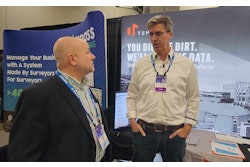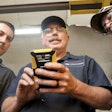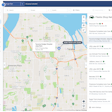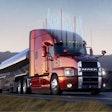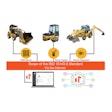
PART I Trackunit Builds Out a Construction Equipment Management Software Platform
PART II DPL Tracks Broad Asset Classes for Dealer and Rental Fleets
PART III LHP Delivering Predictive Analytics with Cummins
Construction-specific software-as-a-service (SaaS) telematics and equipment tracking tools are widely available, ranging from streamlined slap-and-track tech most any contractor can afford to onboard enterprise applications that support the full asset lifecycle of individual machines, equipment classes and fleets.
The Danish Trackunit is among three leading telematics and GPS-enabled equipment management technology companies that focus on meeting the needs of larger fleets. IRONPROS caught up with Trackunit Senior Vice President of Product David Swan in a Q3 2023 debriefing call.
Trackunit has been growing both organically and by acquisition. With its January 2023 acquisition of German construction telematics software vendor Flexcavo, Trackunit gets enhanced capabilities to help contractors and other equipment fleet owners build automated workflows around equipment data to inform dispatching, scheduling and maintenance.
Equipment management through internet of things (IoT) devices requires devices be installed on machines, and installation capacity can be a constraint for growth. So Trackunit announced in October of 2023 it had acquired field service and installation provider OEM Solutions Inc. of Oak Brook, Ill. (OEMSI).
Trackunit is also building out a marketplace of integrated systems, and a platform that enables their partners to extend their solution in new ways and for new use cases.
“Our marketplace platform is in full swing,” Swan said. “We've announced a lot of availability of third-party data systems on our marketplace. This sounds kind of mundane and on the technical side of things. But why this is magic is Trackunit’s core offering is a mixed fleet capability. We see contractors on platforms need to blend all this stuff in. And they're going to end up buying excavators and equipment that come with bespoke telematics on it—that have an OEM-first party telematics portals that Trackunit didn't develop. And what we've done with the marketplace, is we've made it basically plug and play single click to integrate the streams.”
This degree of integration may often be associated with a professional services project, which consumes budget and slows time to value. Not so in this case.
“So now if I'm a midsize contractor, or rental fleet, what I can do is I go to the Trackunit marketplace, I say, ‘Hey, I've got JLG machines or I've got compact machines,’ and I literally just click on the app for that manufacturer, and it automatically configures the data ingestion for those third-party telematics. So, then all I have to do is input my credentials from that OEM and I've got that company's data automatically flowing into my mixed fleet portal without having an IT project.”
From Equipment to Components to Predictive Maintenance
While Trackunit seeks to involve major OEMs in its platform, it is also laying the groundwork to deal with the more complex data from vendors like Cummins that may have sensors on engines, transmissions and other components.
LEARN MORE ABOUT CUMMINS’ PARTNERSIP WITH ELEVAT
“On the machines that have a Can bus, that have controllers on the machine, there is the opportunity to read data off the machine. You could work with a provider to pull data off the machine that is standard SAE J1939,” Cummins Digital Solutions Business Leader Ed Hopkins told IRONPROS. “The way they wrote the standards, all engine manufacturers are put into a very common response for diagnostic messages for things like fuel injectors or fuel systems or oil pressure. But Cummins has a little bit more granularity and more detail we would like to provide these customers than just the standard. What we did with Elevat and other providers is we’re getting the telematics device to speak the Cummins language.”
A vendor like Elevat will pull specific data from components and send them to Cummins for processing.
“What we do with that data is apply algorithms and service history from dealers,” Hopkins said. “And what we can do is send back to our customer an actionable response based on service history of that type of engine with that type of issue. It provides a more useful response than a standard J1939.”
The ability to serve as a clearinghouse for this more complex equipment performance data is something Trackunit can bring to the table according to Swan and plays well into the way the company works with dealer organizations.
Trackunit has a designated service management module that allows dealers to connect to machines they are servicing.
And dealership organizations will likely progress further towards service agreements and other models that increase predictability and reliability for the customer while providing recurring revenue for the dealer.
“When you look at a machine with a three-to-five-year warranty, it is already servitized,” Swan said. “Next year’s sales are based on the service reputation of machines the dealer has sold, and they have responsibility for that warranty satisfaction. The dealer is counting warranty service as an operating expense, and they watch their truck rolls because until a machine they sold is off warranty, they own the uptime. A service organization can back track through the record of down time, and if the cost of service is high, they can look to a different OEM next time.”
IRONPROS is hearing more and more about dealer organizations collaborating with technology vendors on predictive maintenance capabilities that give them greater control. According to Swan, dealer organizations should see a strong financial upside in predictive maintenance that applies machine learning to service history, fault data and condition monitoring to offer prescriptive or predictive maintenance advice.
“Dealers are already selling service,” Swan said. “They want to sell a service contract. There are super simple things coming out of connectivity like visibility into run hours and other data to protect the customer experience. How they connect to this machine is important when they are backing up claims that something is outside of your warranty. A compact excavator that cost between $30,000 and $50,000, eating warranty service for $2,000—that changes their business. If they have visibility into these EPC codes, existing service businesses can gain a 30-50 percent benefit.”
Swan said the natural route to market for AI-driven predictive or prescriptive maintenance will be through equipment rather than software though.
“Most of the dealers are not of the size to have prognostics,” Swan said. “To have that kind of sophistication of data analysis, they're really relying on picking the right OEMs from a component and machine manufacturer level to deliver the machine that could give them prognostics. Obviously, that would change their service sales business dramatically.”
AEMP Plus
While the AEMP telematics standard has helped bridge gaps in mixed fleet management, some useful proprietary data does not cross over. IRONPROS is also learning that large fleets are in a position to negotiate with their OEM for complete access to their proprietary data, an arrangement referred to as AEMP-plus.
“It depends on our partnership, and the philosophy of that OEM,” Swan said. “Some of these OEMs we have deeper partnerships with, and that gives us the opportunity to almost recreate their proprietary telematics offering inside of the Trackunit ecosystem. Then, you're getting full advantage of that proprietary system. Others say, ‘we're going to provide the ISO feed, like the AEMP feed, and that's it.’”
Emissions Reporting with Trackunit
At the time of our briefing, Swan provided a preview of new emissions tracking functionality in Trackunit, which launched in Q3.
“We've developed a machine learning algorithm that epitomizes this idea of no machine left behind,” Swan said. “So, the problem is that you have super fancy stage five engines that report on the amount of fuel consumed. You can get ultra-accurate emissions reporting in, you know, kilograms of CO2 output from these diesel engines. And then you have a ton of machines out there that have less sophisticated mechanical engines without an emissions control unit on them. And then you have electric machines that do have a CO2 impact, but through electrical consumption related to generation sources. We've created a model that can accurately model a three-wire connection to a sophisticated stage five, direct fuel burned engine. We can take just the run hours off a diesel machine, and within 10% accuracy, model it to the CO2 output of a full blown, connected engine. And this means that across our entire fleet of, you know, over a million and a half machines with construction machinery, we can go to any contractor, say here's the actual CO2 output of this group of machines that you're running on this project and give you a live CO2 report.”
Having data is only worthwhile if it is actionable, and Swan said the emissions reporting should be immediately useful.
“Imagine that now you have data on your CO2 impact,” Swan said. “We know this is accurate within maybe 1%. You can then take actions to measure it and decrease it week over week. That's like game changing, just being able to model your entire fleet and for instance lower idling time by 12%, because that'll decrease the emissions on the site by 7%.”

